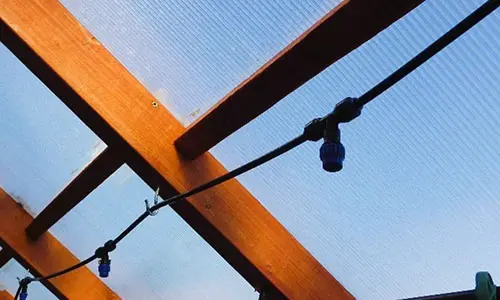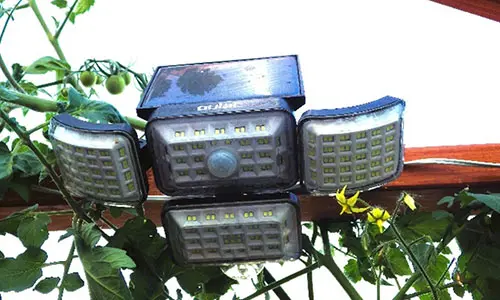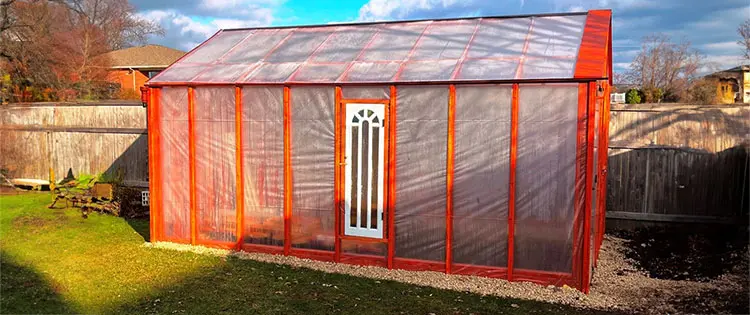You already know my article about how I built my greenhouse and I wanted to share some valuable insights about maintaining one. We can call it a Greenhouse 101 guide if you want.
I built a greenhouse for my daughter and was quite proud of it. She was thrilled and couldn’t believe how big it was and all of the things she could now plant and grow. And then -one day… the temperature spiked to 100 degrees Fahrenheit or about 38 degrees Celsius. She called me in a panic. She said the inside of the greenhouse was really hot and opening the door and window wasn’t helping.
When I got to her house, I measured the interior temperature using my iPhone. Inside it was 117 degrees F or 47 degrees C.
We found an old fan in her garage and set that up at the window, but I knew I had to find some better solutions. What follows worked but it took some planning, investment, and time.

Greenhouse 101: The Critical Measures
Two things affect the health of plants in a greenhouse: temperature and humidity. My first step was to buy an electronic temperature and humidity gauge that actually had Bluetooth connectivity.
I bought it on Amazon and liked the fact that she could check what was going on in her greenhouse using her iPhone. I connected it to my iPhone as well just so I could be a backup if she was busy or out and about.
But knowing what’s going on does little to solve or alleviate temperature or humidity spikes. High temperature is the obvious villain when it comes to the health of plants, but excessive humidity can promote mold and fungal growth as well. We needed to find some solutions.
Solar Powered Fans
Most greenhouses use roof panels to vent hot air, but we took it further by installing small fans near the ceiling at both ends of the greenhouse. Powered by a solar panel, the fans run all day and into the night, thanks to a small battery. During cold weather, we turn them off, but in summer, they stay on constantly.
To maintain the ideal greenhouse temperature of 80°F (27°C), we used a Bluetooth temperature gauge, which made monitoring easy. Managing humidity, however, proved more challenging. Greenhouses thrive at 80% humidity, but the fans exhausted both heat and moisture. Clearly, we still had work to do.

Greenhouse 101: Why You Should Add A Rainwater Collection Barrel
The greenhouse had no gutters on the roof, but as I learned more about rainwater collection, I installed some simple gutters and drained them into a PVC reducer that I used as a funnel.
I connected other pieces of PVC to direct the rainwater into a barrel inside the greenhouse. The top of the rain barrel is open with a screen to filter out debris.

The open top helped a lot to maintain humidity. It was a black barrel that held heat in winter and encouraged some evaporation in summer. It did the trick and even with the fans blowing we maintained a humidity level of around 80%. Rarely perfect but close enough.
The rain barrel also made watering easier with a watering can but watering was still a challenge as the greenhouse flourished.
Greenhouse 101: An Automatic Watering System
My daughter’s husband came across a series of hoses with water jets that could be suspended above the plants. When you hook up a hose from the house or even the rain barrel it sprays water onto the plants like they do in the produce section of grocery stores. That made watering a lot simpler and while some plants still needed to be watered with a can or hose, it reduced the amount of time we spent watering all of the plants.
What complicated things a bit was both my daughter and her husband work and sometimes they found themselves taking care of things in the greenhouse in the dark of night. Flashlights were the first solution but then we got smart.

Motion Detector Solar Lights
Greenhouses get plenty of sun, and I found a great way to make use of it. While browsing Amazon, I discovered motion detector solar lights and thought, “Why not?”
I installed two lights, one at each end of the greenhouse, ensuring the solar panels faced the sunniest spots. They work perfectly. At night, the lights automatically turn on when you walk in, filling the entire space with bright light. Once you leave, they shut off after 30 seconds without detecting motion.
However, this led to a new challenge. One night, my daughter noticed the greenhouse lights flickering on and off from her house. Concerned, she wondered if temperature fluctuations were causing the issue or if someone was inside. It turned out something was inside: a rabbit! The sneaky intruder had chewed through many of the young plants on the bottom shelves.

Rabbit and Rodent Proofing Your Greenhouse
The rabbit invader was a new challenge and my daughter and I found a few solutions. The first was to build a small door with chicken wire across the bottom of the front door. She would leave the door open on hot days (she had to), but the small drop in door did a pretty good job of keeping the rabbit out.
In Greenhouse 101, pest management is key to protecting your plants. One creative solution involved thinking carefully about what to keep on the bottom, rabbit-accessible shelf. Soon enough, young marigold plants found their way there. Rabbits hate the smell of marigolds and are naturally repelled by them, so now she grows a lot of marigolds.
Another helpful tip from the greenhouse 101 playbook is to use an ultra-high frequency transmitter to repel rabbits and rodents. These devices aren’t very expensive, and you can even find solar-rechargeable options on Amazon. While we can’t hear the frequency, small animals do, making it an effective deterrent against unwanted visitors, whether they come by night or day.

It’s Working
It took a bit of investment and small amount of time, but it’s all working now. The temperature and humidity is both managed and easily measured; there’s light at night and the animals have fled the building. The result is that the greenhouse has become a pleasure and the plants are thriving.
Do you have a greenhouse? How do you keep it running smoothly? Share your tips in the comments below!
PVC Handpump for Tapping into the Fresh Water Under Your Property (Video)
What Should I Feed My Chickens In Winter?
I Tried Drinking Water From My Stockpile and This Is What Happened



















